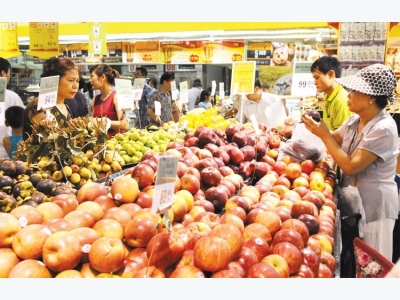Vietnam seeks to restrain fruit, vegetable imports

Fruit and vegetables have become one of Vietnam’s key exports in the agriculture, forestry and fishery group with an average growth of 30 percent per month. However, Vietnam also imports a large volume of fruit and vegetables, including some that are domestically produced.
According to the General Department of Vietnam Customs, fruit and vegetable imports reached US$924.9 million in 2016, an increase of 47.2 percent compared to 2015. This figure stood at US$405 million in the first five months of this year, and is forecast to exceed US$1 billion this year. Thailand continues to be the largest fruit and vegetable supplier to Vietnam, accounting for more than 50 percent of total import turnover, followed by China with 19 percent, the US with 6.7 percent and Myanmar with 4.5 percent.
While consumers in rural and remote areas buy Chinese fruit and vegetables at cheap prices, those in large cities mainly select imported fruit from the US, Japan, the Republic of Korea, Thailand and Australia. In particular, imported fruit from Thailand is increasingly engaging the attention of Vietnamese consumers due to good prices and guaranteed quality.
Le Quoc Phuong, deputy director of the Ministry of Industry and Trade’s Vietnam Industry and Trade Information Center, says Vietnam is participating in the international economic integration process. Therefore, other countries are able to export their goods to Vietnam. In addition, Vietnam still imports some kinds of fruit and vegetables that the country is unable to produce.
A strong growth in fruit and vegetable imports is partly due to the quality of domestically produced goods. Some use of chemical substances on fruit has made consumers anxious, while branding remains limited.
Deputy Minister of Industry and Trade Do Thang Hai says the ministry will promote the Buy Vietnamese Goods campaign so that consumers will increasingly give priority to domestically produced goods, including fruit and vegetables.
Businesses need to see the domestic market as an important market for high-quality goods, instead of giving priority to exports. Le Quoc Phuong says businesses should also invest more in high-tech agriculture to produce clean products.
The state, ministries and departments should formulate policies to support businesses. In addition, fairs, exhibitions and other trade promotion activities should be undertaken to introduce Vietnamese fruit and vegetables to consumers.
The main imported fruit and vegetables to Vietnam consist of New Zealand and Australia’s apples, oranges, pears, kiwi, cherries and grapes; Thailand’s durian,mangos and Siamese custard apples; China’s cabbages, potatoes and oranges.
Có thể bạn quan tâm
 Asia Coffee-Vietnam, Indonesia discounts widen but in slow trade
Asia Coffee-Vietnam, Indonesia discounts widen but in slow trade Discounts in Vietnam and Indonesia, Asia's top coffee exporters, widened as world coffee prices rose, but trading was thin in both markets
 Material supply matters to cashew industry of Vietnam
Material supply matters to cashew industry of Vietnam About 500,000 tonnes of material cashew nuts will be imported from now to October to serve processing and meet the targeted export volume of 360,000 tonnes
 Where’s Vietnam in the global value chain?
Where’s Vietnam in the global value chain? Ten years ago, the risk for Vietnam was that it might miss the glbal ‘integration train’. Today, the question is where is Vietnam in that train?